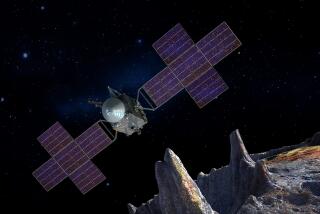Closing In on the Mystery of Chiron
- Share via
Out beyond Saturn there is something that has been puzzling astronomers for a dozen years. It is some sort of heavenly body, but exactly what kind was unclear. Now, its true identity may finally be emerging.
The story started on Nov. 1, 1977, when the American astronomer Charles Kowal discovered what seemed to be an asteroid that was moving slowly, very slowly. The more slowly an asteroid moves, the farther it is from the sun, and this one was farther than any asteroid ever seen, for it circled the sun beyond the orbit of Saturn.
The only small objects that had ever been seen as far as Saturn or beyond were the satellites that circled the distant planets: Saturn, Uranus, Neptune and Pluto. What Kowal had discovered was a small object that moves in an independent orbit around the sun, moving around it sometimes at about the distance of Saturn’s orbit, and then moving out as far away as the orbit of Uranus. Its orbit is tilted in such a way, however, that it stays far below or above those two planets as it moves through its own orbit. There is no danger of a collision.
Kowal looked for it in old photographs of appropriate portions of the sky and worked out its orbit. It circled the sun every 51 years. Its orbit carried it to within 790 million miles of the sun at one end and out as far as 1,740 million miles at the other end. Because it seems to gallop endlessly closer to and further from the orbits of Saturn to Uranus, Kowal named it “Chiron” after the most famous centaur (those half-man, half-horse creatures) in the Greek myths.
The question arose as to what it might be. It might be an asteroid. It is fairly large, for it is 112 miles across, but there are asteroids of that size known. The only trouble with that notion is its distance from the sun. All the asteroids we know have all or part of their orbits in the space between Jupiter and Mars (the “asteroid belt”). A few tiny asteroids are known with orbits inside that of Mars, but Chiron would be the only asteroid we know with an orbit that lies entirely beyond that of Jupiter.
Of course, the more distant an asteroid, the harder it is to see. Perhaps the outer solar system beyond Jupiter is littered with asteroids, which are so far away we can’t see them from Earth. Perhaps we only just barely make out Chiron because it is unusually large for an asteroid. Perhaps when the day comes that we have telescopes in orbit far out in space, we will discover many more Chiron-like objects.
On the other hand, Chiron may be a comet. Comets are known to exist far out in the solar system. Chiron is large for a comet, to be sure, some 2,000 times as massive as Halley’s comet, for instance, but perhaps some comets might be that large.
Chiron showed no signs of being a comet, however. There is this difference between an asteroid and a comet: An asteroid is made up, mostly or entirely, of rocky or metallic materials that do not vaporize even when red hot. A comet is made up mostly of icy materials that vaporize when heated, forming a dusty cloud about itself. That’s why comets, as they near the sun, grow fuzzy and develop a long tail.
Chiron showed no signs of fuzziness, but that may be because it is so far from the sun that it receives insufficient heat to vaporize its ice. Chiron was, however, near its maximum distance from the sun when it was discovered in 1977, and it has been approaching ever since. It will reach its minimum distance in 1996.
That means that since it was discovered, it has been edging closer and closer to the sun and getting warmer and warmer.
Naturally, as it gets closer to the sun, it receives and reflects more light so that it gets brighter. Astronomers have a pretty good idea as to just how an asteroid would brighten as it approaches the sun, and even as early as November, 1987, it seemed that Chiron was becoming just a little brighter than it ought to be.
Now, Karen J. Meech of the University of Hawaii and Michael J. S. Belton at Kitt Peak Observatory in Tucson, report further brightening that can only be the result of sunlight reflected from an atmosphere of vapors developing about Chiron. This would seem to mean that Chiron is not an asteroid but a giant comet after all.
Perhaps it is not unusually large for a comet. Perhaps very many of the comets that are thought to exist far beyond the orbit of Pluto, are that large. The ones we see close up, after all, are those that come into our own vicinity, very near the sun, over and over again. Each time they approach the sun, much of their substance vaporizes so that they are now much smaller than they once were.
If an object as large as Chiron had its orbit altered by planetary pull and was made to drop into our section of the solar system, it would lose so much vapor that it would develop a giant cloud about itself that would be larger than the sun, and a tail that would be hundreds of millions of miles long and stretch halfway across the sky. Several giant comets like that were observed in the 1800s, but in our own century, alas, we have seen only puny examples. We can only stare at Chiron and think of the sights we are missing.






